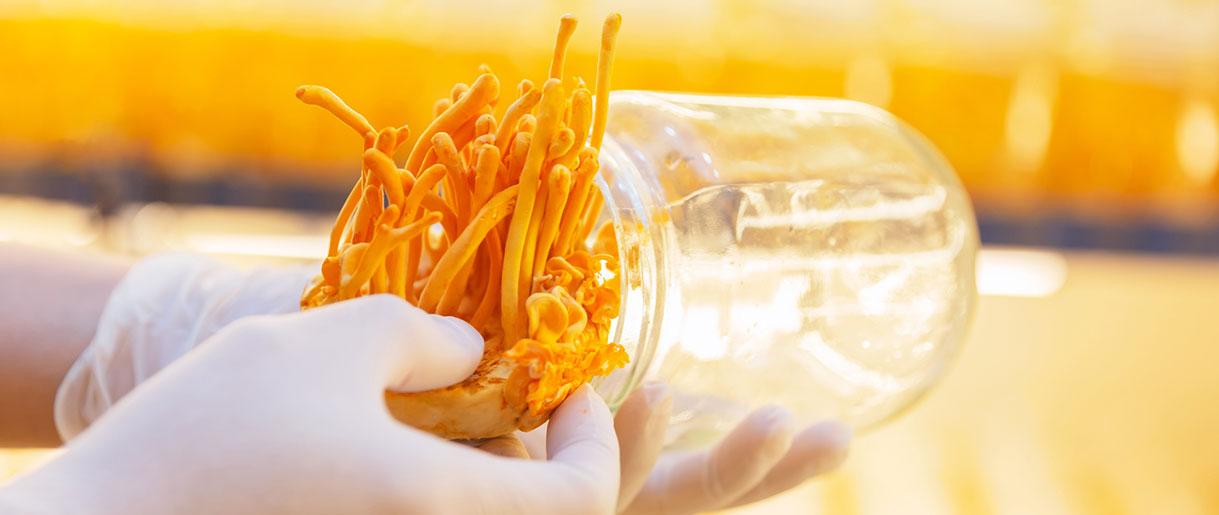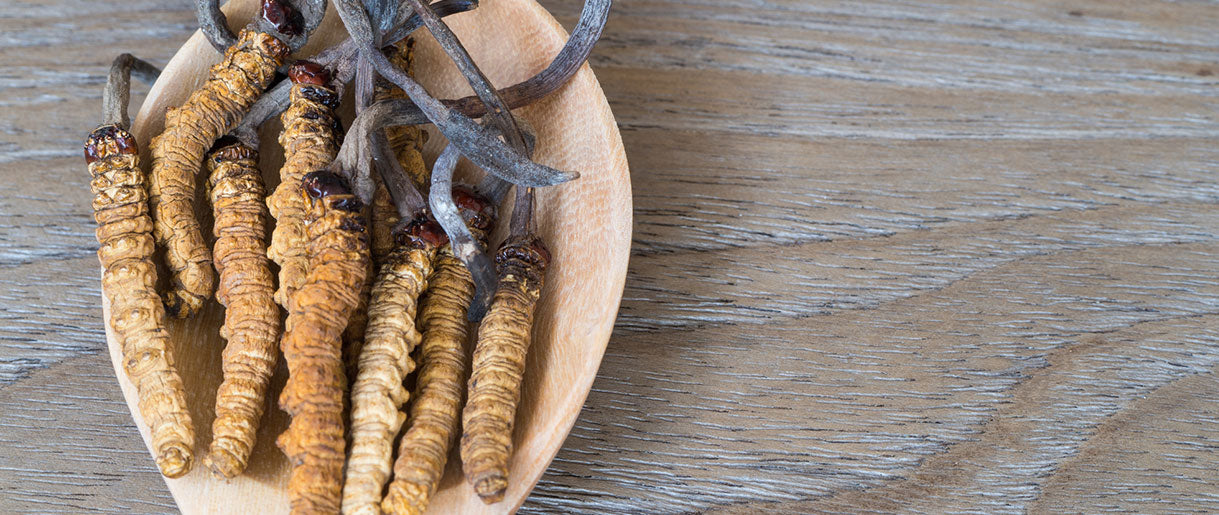Cordyceps mushrooms are a popular ingredient in Traditional Chinese Medicine and have been used for centuries. It has been described as a mushroom with healing properties in traditional Chinese and Tibetan medicine books.
But where do cordyceps mushrooms come from, and what is their history? This post will explore the origins of cordyceps mushrooms and their use throughout the years.
Let's start by understanding this mysterious fungus.
What Is Cordyceps, The Caterpillar Fungus?
Cordyceps in Chinese is known as Dong Chong Xia Cao, which translates to "winter bug, summer grass." It is an unusual but beneficial medicinal mushroom that has long been regarded highly in Chinese medicine.
Read More: Learn the benefits of cordyceps mushrooms.
So what exactly is this mushroom? A fungus? A parasite?
Found in the Tibetan plateau, the Cordyceps mushroom is one of the world's most valuable fungi. It parasitizes the larvae of ghost moths, a specific genus in the Himalayas between the elevations of 3000 to 5000 meters.
So what exactly happens here?
The fungus first infects the living caterpillar in the summer while they feed on plant roots underground. It then grows in the insect's body in the fall and winter while slowly consuming them. Finally, the fungus kills and mummifies its host.
When the overlying snow melts in the spring, the fungus forces its host towards the surface. A dark brown, spore-filled, stalk-like fruiting body emerges from the corpse. It is a few centimeters long and stands upright. For this reason, it is locally known as "yartsa gunbu."
The entire fungus-caterpillar body is then hand-collected and harvested. The harvested cordyceps mushroom is highly valued as a medicine by herbalists.
In China, they say, "those who buy it don't eat it, and those who eat it don't buy it.". Some say the Chinese medicine cordyceps is worth three times its weight in gold!
We can't say this with absolute certainty, but we know that in Bhutan (one of the countries where people harvest the fungus), cordyceps accounts for a significant slice of the country's gross domestic product.
Now let's go back to the roots of this mushroom!
Cordyceps Chinese Herbal Medicine: History
Cordyceps Sinensis has been officially recorded as a herbal drug in Chinese pharmacopeia(1) since 1964. But its use dates long back to traditional Chinese medicine.
Cordyceps is one of the longest-used medicinal herbs in Asian cultures, with its benefits ranging from anti-aging properties to treating cancer cells.
Read More: Learn how cordyceps treats cancer.
Research findings suggest using caterpillar fungus as a folk medicine originated in Nepal and Tibet before moving to southwestern China. The oldest known document mentioning its usage is "Man ngag bye ba ring bsrel"(2) or "Instructions on a Myriad of Medicines," written in the 15th century. Here, the mushroom has been described as an aphrodisiac.
Read More: See how cordyceps boosts libido.
In traditional Chinese medicine, C. Sinensis was first mentioned(3) in 1694. However, the fungus entered the global spotlight much later.
In September of 1993, Chinese track and field athletes smashed several world records(4), a feat attributed to the consumption of the caterpillar fungus. This unearthed the fungus, catapulting it into a valuable commodity.
Now, you may come across queries like, is Cordyceps a yin or yang? In Chinese medicine, cordyceps is a herb possessing(5) 'Yin-nourishing' and 'Yang-invigorating' activities. Some say the mushroom balances yin and yang because it is composed of animals and vegetables.
Today, cordyceps is not just used in traditional Chinese homes. The mushroom has demonstrated its ability to promote better health and has been approved by the food and drug administration as a dietary supplement in western medicine.
Read More: What is the best time to take cordyceps?
The following section will examine why cordyceps use is becoming increasingly popular in western medicine.
Cordyceps Benefits in Chinese Medicine

Cordyceps mushrooms have high status in Chinese medicine thanks to their health benefits.
Traditional Chinese medicine supports that cordyceps mushrooms can strengthen the kidneys(6) and lungs, benefiting people with kidney and respiratory problems.
The mushroom also helped improve a person's essential vitality. Research has verified that Cordyceps is an effective ingredient for treating people with chronic kidney disease(7).
Read More: See how cordyceps improves kidney health.
Even the traditional healers of North India recommend cordyceps mushrooms as a tonic for all illnesses(8). They recommend using the fungus as it increases endurance, stamina, libido, and sleeping patterns.
Scientific research(9) shows the health benefits of cordyceps result from bioactive compounds like cordycepin, ergosterol, polysaccharides, glycoproteins, and peptides containing α-aminoisobutyric acid.
Below, we will examine some of the uses cordyceps has been put to in Chinese history—we will look at modern research studies to verify whether cordyceps products indeed offer these benefits today:
1. Cordyceps Has Been Used To Boost Exercise Performance
One of the main reasons people used Cordyceps in Chinese medicine is to boost their exercise performance. Cordyceps pre-workout benefits gained world attention in 1993 when Chinese female runners achieved records in the 10,000 m, 3,000 m, and 1,500 m events.
The women's coach attributed the team's performance and advanced function on the running tracks to a diet that contains cordyceps.
A research study conducted in 2010(10) to analyze the impact of cordyceps Sinensis and Militaris on fatigue and performance during exercise proved that supplementation with CS-4 (cordyceps Sinensis) leads to improved wellness and better performance in older adults.
2. Chinese Used Cordyceps For Asthma
Cordyceps Sinensis is a top-rated remedy for asthma conditions. Chinese researchers conducted a study(11) between 2014 and 2015 to determine whether the mushroom effectively treated asthma infection. The study was conducted at Xuanwu Hospital.
The enrolled study subjects were at least 18 years old and were diagnosed with severe or moderate asthma, whose symptoms included fixed airflow obstruction.
The research study concluded that the cordyceps Sinensis mushroom species reduced asthma symptoms and the frequency and intensity of asthma attacks while considerably lessening inflammation brought on by asthma during the 3-month intervention period, as seen by a decline in the expression of inflammatory biomarkers.
Read More: See how cordyceps boost lung health.
3. Traditional Chinese Medicine Used Cordyceps To Improve Sexual Function
To verify whether Cordyceps effectively treated libido problems in the traditional Chinese population, researchers studied Chinese participants in Huashan Hospital in Shanghai, China.
In the study, researchers examined the effects of cordyceps on 286 impotent males. Forty days of taking 1gram of cordyceps three times daily improved sexual performance and sex life for 183 patients.
The evidence from this research literature showed that the mushroom is effective in helping any patient dealing with libido problems.
Read More: Learn how cordyceps boosts testosterone to boost sexual function.
4. Traditional Chinese Medicine Used Cordyceps For Diabetes
Diabetes is a common health condition whose prevalence rate is increasing in different parts of the world. The disease carries a range of long-term adverse effects, including decreasing kidney function, neuropathy, and much more. However, cordyceps helps with diabetes treatment.
To ascertain that Cordyceps mushroom could benefit the Chinese population in treating diabetes, Chinese researchers did a study in 2021(12). The research authors concluded that cordyceps mushrooms carry beneficial impacts on diabetes.
They suggested that the mushroom can be used as one of the diabetes treatment therapies, although the patient may still need to visit a doctor so that they can combine cordyceps with other treatment options.
Read More: See the benefits of combining Chaga and Cordyceps.
5. Traditional Chinese Medicine Has Used Cordyceps In Cancer Treatment
Research studies show that Cordyceps also offers cancer benefits. The mushroom has been doing this for hundreds of years in the Chinese community.
In 2018, Chinese researchers analyzed cordyceps' impact on cancer in a group of Chinese participants. The 2018 research study concluded(13) that cordyceps has potent anti-metastasis activity in a mouse breast cancer metastasis model, possibly by down-regulation of the expression of several metastasis-related cytokines.
Key Takeaways
Cordyceps is a Chinese medicinal herb revered for its many health benefits. There is a wide range of reported use of this high-altitude Himalayan mushroom in traditional medicine books.
From protecting the lungs to the kidneys, the fungus has a long-standing historical presence. Even today, Cordyceps Sinensis has received tremendous public attention due to its purported benefits, such as analgesic, aphrodisiac, anti-oxidant, and immune modulator, to name a few.
If you're curious about trying cordyceps mushrooms, there are a few ways. You can find them fresh or dried at most Asian markets or purchase them online.
Have you tried cordyceps mushrooms? Let us know in the comments!
References
- Cordyceps as an Herbal Drug, (1)https://www.ncbi.nlm.nih.gov/books/NBK92758/
- The Tibetan and Himalayan library, (2)https://www.thlib.org/collections/texts/jiats/#!jiats=/04/winkler/
- Yartsa Gunbu (Cordyceps sinensis) and the Fungal Commodification of Tibet’s Rural Economy, (3)https://link.springer.com/article/10.1007/s12231-008-9038-3
- The traditional Chinese medicine Cordyceps sinensis and its effects on apoptotic homeostasis, (4)https://www.sciencedirect.com/science/article/abs/pii/S0378874104004696
- Pharmacological basis of 'Yin-nourishing' and 'Yang-invigorating' actions of Cordyceps, a Chinese tonifying herb, (5)https://pubmed.ncbi.nlm.nih.gov/15530501/
- Cordyceps – A traditional Chinese medicine and another fungal therapeutic biofactory?, (6)https://www.ncbi.nlm.nih.gov/pmc/articles/PMC7111646/
- Cordyceps sinensis (a traditional Chinese medicine) for treating chronic kidney disease, (7) https://www.cochranelibrary.com/cdsr/doi/10.1002/14651858.CD008353.pub2/full
- Traditional uses and medicinal potential of Cordyceps sinensis of Sikkim, (8)https://www.ncbi.nlm.nih.gov/pmc/articles/PMC3121254/
- Cordyceps – A traditional Chinese medicine and another fungal therapeutic biofactory?, (9)https://www.ncbi.nlm.nih.gov/pmc/articles/PMC7111646/
- Effect of Cs-4® (Cordyceps sinensis) on Exercise Performance in Healthy Older Subjects: A Double-Blind, Placebo-Controlled Trial, (10)https://www.ncbi.nlm.nih.gov/pmc/articles/PMC3110835/
- Herbal Medicine Cordyceps sinensis Improves Health-Related Quality of Life in Moderate-to-Severe Asthma, (11)https://www.ncbi.nlm.nih.gov/pmc/articles/PMC5165155/
- Therapeutic effects of Chinese herbal medicines and their extracts on diabetes, (12)https://www.sciencedirect.com/science/article/pii/S0753332221007599
- Extracts of Cordyceps sinensis inhibit breast cancer cell metastasis via down-regulation of metastasis-related cytokines expression, (13)https://pubmed.ncbi.nlm.nih.gov/29253616/









Let Us Know Your Comments